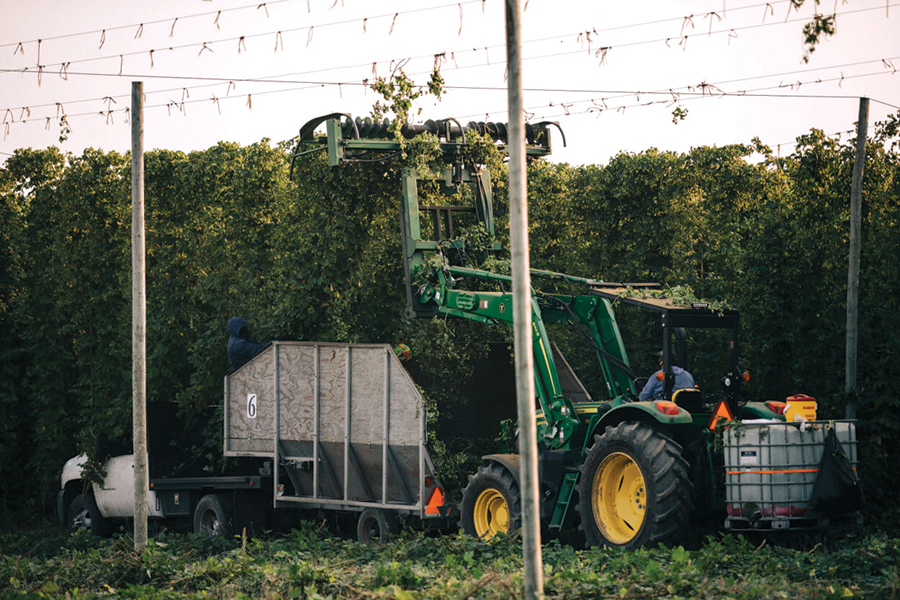
Home » Growers work to align supply with demand
Smaller hop crop
Growers work to align supply with demand

June 14, 2024
Hops growers faced a difficult 2023, and times may get tougher in 2024 with the industry bracing for its smallest crop yet.
“Last year we had a decline in hop production, and we’re trying to correct (the oversupply),” said Maggie Elliot, science and communications director for the Hop Growers of Washington. “We’re entering a really challenging time, and possibly looking at 17% to 20% cuts in hop production.”
Jason Champoux agreed with Elliot. He is the vice president of crop production at Yakima Chief — a grower-owned global hop supplier with a mission to connect brewers with family hop farms.
“From our perspective we’re bringing in dramatically less (hops),” he said. “In 2024 we’re expecting our smallest crop yet.”
Contributing to the problem is a craft beer market that is starting to plateau, with the market for aroma hops softening. Supply chain woes and a large stash of hops in storage also pose issues.
“Hops can be stored for three to five years of inventory,” Elliot said. “Plus, some hops are used for extract. That can remain in storage for 10 years.”
Balancing inventory
Much of the cutback in hop acreage has been concentrated on aroma and dual-purpose varieties.
Aroma hops production dropped by 18.5% in 2023.
Aroma hops contribute to the aromatic depth that craft brewers use to create unique and different flavors.
Growers pared back the acreage for Citra HBC 394 — the most produced of aroma hops since 2016 — by 26% in 2023 to 8,856 acres planted. Still, it’s the most dominant aroma hop grown.
The acreage of Alpha hops, a variety which provides the distinctive bitter taste to beers, increased 36.7% in 2023, with Super Alpha CTZ jumping back into second place — behind Citra HBC 394 — with 6,354 acres planted.
Aroma and dual-purpose varieties dropped from 82% of the total acreage planted to 74%, while alpha varieties increased from 18% to 26%.
By the numbers
In 2023, 104.9 million pounds of hops were produced in the U.S., with all but 900,000 pounds produced in the Pacific Northwest.
The U.S. grows more hops than any country in the world, including Germany, and exports hops to numerous countries, with the three largest importers being Belgium-Luxembourg, Germany and Canada.
In all, the U.S. exported more than 17,000 pounds of hops in 2023.
The remaining inventory remains in the U.S.
Washington grows 74% of all hops produced in the Northwest, valued at $406 million in 2023, while Idaho produces 16% and Oregon 10%.
But for the first time in 12 years, growers idled acres and swapped out hop varieties — shifting from an oversupply of aroma and dual-purpose varieties to alpha hops in 2023.
As a result, there were 10% fewer acres planted in hops in Washington, Oregon and Idaho in 2023.
And it could be even worse in 2024.
 Courtesy Hop Growers of America
Courtesy Hop Growers of America“The supply chain has a glut,” Elliot said. “Last year the production was down 10%. This year we’re looking at 20% down.”
Yields were still rising from that limited acreage, up 13% over the 10-year average of 1,915 pounds per acre in the Pacific Northwest.
Altogether, more than 54,000 acres were growing hops in 2023. That’s a drop of more than 5,000 acres over the previous year.
Still, production was up year-over-year by roughly 2.1 million pounds in 2023. And the yield-per-acre was way up compared to the previous year — 1,915 in 2023, to 1,694 in 2022.
Rising costs of producing hops brought the value way down.
In 2023, the overall value of Pacific Northwest hops totaled $562.2 million, compared to $621.1 million the previous year.
How did this happen?
According to a Hop Growers of America January report, “Growers have faced substantial increases in the cost of production, driven by expansion of harvesting and production capacity to handle a doubling of acreage over the past 10 years, updating equipment, increased labor costs (including health care and other benefits), and inflation in the cost of production inputs.”
The report continues to state that administrative and operating costs associated with food safety, best practices compliance and other customer requirements also have increased.
Craft beer market
Washington state produces 560,967 barrels of craft beer a year, which ranks 11th in the U.S., according to the Brewers Association.
But since 2020, the number of craft breweries has leveled off in Washington, holding steady at just over 400.
The association said overall U.S. beer production and imports were down 5% in 2023, while craft brewer volume sales declined by 1%.
Beverage Daily stated that craft beer suffered during the pandemic in 2020 but had largely recovered the following year.
But rising operating and material costs, supply chain challenges and increased competition have hit the market hard.
That’s been causing small brewers to be sold or shut down completely.
“It’s very unfortunate,” Elliot said. “Two of the biggest companies, Anheuser Busch InBev and Ambev, they’re divesting of their craft breweries.”
Champoux also added that consumers are changing their drinking habits.
“In the brewing industry, we’re seeing people are drinking less,” Champoux said. “People are drinking more seltzers and RTDs (ready-to-drink alcoholic beverages). And Covid was kind of a reset from a health perspective for many beer drinkers.”
Then there is inflation.
“Beer brings people together,” Champoux said. “Costs are going up, especially when you see that it costs $14 for a four pack in the store. Everything has gone up, unfortunately. For many people, beer is a luxury item.”
Crop rotation
“We are seeing less acreage in the Yakima Valley being used for hops,” Elliot said. “But it’s hard to change to another crop, although there have been instances of corn and Concord grapes being grown in the rows.”
Hops are a permanent product, Elliot said. There is the investment in the plants, plus trellis structure expenses, which take a lot of manpower to produce, and make it difficult for growers to plant anything else.
“Farmers understand hops can be a volatile market. They understand there can be major swings,” Elliot said.
That includes labor.
The federal government’s H-2A guest worker programs, which allow those from other countries to work in temporary agricultural jobs, have added more requirements which means “we’re seeing more use in domestic labor,” Elliot said. “Growers are trying to have a larger work force. Growers are implementing more shifts.”
Challenges with water also bring uncertainty to the industry.
The Roza Irrigation District, which manages the water system in the Yakima Valley, shut down for 10 days in May due to water rationing.
The state is expecting a drought this summer, so officials thought this would be a good time to shut water supply down since there are cooler temperatures.
Elliot says that it’s a tough time no matter what the crop is.
“Some crops, such as hay and grasses, need that water now,” she said. “But permanent crops like tree fruit and hops, they need water into September. There is just not enough water.”
The pain will be felt by area farmers, but it’s something that needs to happen.
“We are entering a really hard correction. It’s a hard time,” Elliot said.
Champoux believes it’s a solvable situation.
“These are cycles. It’s not any different if it involved wheat or fruit trees,” he said. “We have to align supply with demand.”
Focus Magazine Agriculture + Viticulture




